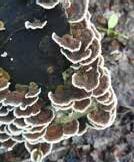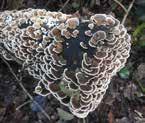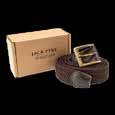












Has everyone survived the most miserable month in the calendar?! I feel like every Monday in Jan has an adjective attached to it or at least it should – not sure Blue Monday covers it! Maybe it should be something like:
Pretend Monday – i.e., it’s probably a BH.
Same old Monday – i.e., did we even have a break?


Blue Monday – i.e., most miserable and saddest day of the year.
Skint Monday – i.e., it’s been 6 years since the last payday.
Never ending Monday - i.e., how has this month still got another Monday in it!!
Still, we got through it didn’t we! Just about!!
Speaking of getting through, the most unwelcome Birthday came and went – I tried to do nice things and be positive and whatnot but I’m not a fan! It was only about 20mins ago when I was a whipper snapper and I used to call people of my age ‘old’. Yet, I’m not quite old enough to forget that this was the case!! I’m also not a ripe cheese or a fine wine! But as my old Grandma used to say – “it’s better
than the alternative!” She weren’t wrong! So, I’ll sulk for a little bit longer about it and then I’ll start getting some Botox and all will be well with the world!
Anyhoo, hard to believe we’re in our 13th year of production but we are all hugely looking forward to helping our local businesses this year and we’ve got some good ideas in the pipeline to try and help – so keep your eyes peeled.
I’m off to put my slippers on – yep, gone are the days of bare feet or just socks #sadtimes.
Happy Reading!

A quick recap for those who aren’t sure why we feel the need to stuff ourselves with pancakes on that day!
Shrove Tuesday is a moveable feast, its date is tied to whenever Easter falls as it is celebrated on the last Tuesday before the 40-day period of Lent begins. Easter itself is the first Sunday after the full Moon that occurs on or after the spring equinox. If the full Moon falls on a Sunday, then Easter is the next Sunday.
Lent, as you may recall, is the six-week period in the run up to Easter when traditionally Christians would fast - avoiding meat, fish, eggs, and fats until Easter Sunday. These days we are more likely to commit to giving up just one thing for the duration of Lent - is this something you do, or would consider doing?
Anyways, back to Pancake Day/Shrove Tuesday, which this year falls on February 21st.
As the story goes, our forebears would cook up a storm on the day before Lent (aka Shrove Tuesday) in order to use up any eggs, milk, and other perishable foodstuffs, before beginning their prolonged fast period.
Quite why pancakes have become synonymous with Shrove Tuesday is somewhat lost on me. I can see that eggs and milk may have needed to be used…but not flour, the other vital ingredient in a pancake batter mix.
I wonder if Yorkshire Pud’s were also consumed on Shrove Tuesday - maybe a first course of meat and gravy in a Yorkshire pudding, followed by pancakes…batter overload.
We may have lost many of the traditions connected with Lent, including that of marking the heads of worshippers with ashes taken after the burning of Palm branches (or crosses made from Palm leaves) from the previous year’s Palm Sunday celebrations, but Pancake Day lives on.
Every household will have their own way of making pancakes.
Some will toss.
Some will flip.
Some organised people will make a stack of pancakes.
Some will operate a one at a time production line.
And some won’t bother making pancakes on Shrove Tuesday at all!
As for what goes on a pancake - well, let’s not open that can of worms and simply say that whatever you want to top your pancakes with is absolutely fine.
Unless it’s chocolate spread, in which case you need to go and have a word with yourself <grin>.
Whatever you do this Pancake Day, it is still worth looking back at some of the older, thriftier ways of cooking. Times when nothing was wasted, leftovers were made into another meal and very little food was thrown away.
In these financially tough times, there are lessons to be learned from the past.

Pancake Day - Shrove Tuesdaywe all know the origins of the day…don’t we?







Daily hire, short & long term hire
30 POINT SERVICE including:
Battery, Charging Points, Tyres, Lights & much more, helping you stay safe. Call for details.
Ask about our scooter and equipment repairs and maintenance service.

Safety checks and driving test available






























Contact Sarah on 0115 849 2386
@Prioritystairlifts /prioritystairlifts




Local Installation, Repairs and Servicing of Stairlifts
■ Local, family-run business
■ Almost 20 years’ experience
■ New, reconditioned and rental available
■ Friendly, personal service
■ Free, no obligation survey

■ 24/7, 365 days call-out
■ Repair and service all makes of stairlifts

■ Members of Age UK
info@prioritystairlifts.co.uk
www.prioritystairlifts.co.uk

Air Fryer Roast Chicken Dinner

Method
1. Preheat your air fryer to 180°C.
2. Put the potatoes in the air fryer basket, spray with low-calorie cooking spray and cook for 10 minutes, shaking the basket halfway.
3. At the same time, blitz the broccoli in a food processor, add the cheese and some seasoning and blitz again until combined.
4. Put the chicken on a board and cut a large pocket into the long side of each breast. Squash the broccoli and cheese mixture into each opening until it’s all used up, and season the chicken with freshly ground black pepper.
For more information visit www.slimmingworld.co.uk
Are you an Air Fryer convert? This simple but yummy recipe works perfectly and is just 4 syns per serving!
5. Remove the basket from the air fryer and shake the potatoes. Put the chicken breasts on top, spray with low-calorie cooking spray and cook for 18-20 minutes or until the chicken is cooked through, carefully turning the chicken after 10 minutes.
6. Make up the gravy. Put the chicken on 2 plates and serve with the potatoes, gravy and your favourite Speed vegetables.
7. TO OVEN COOK: Cook in a nonstick roasting tray at 200°C/fan 180°C/gas 6 for 35-40 minutes or until cooked through, adding the chicken after 10 minutes.
Serves: 2
Ready in: 35 mins
Ingredients:
300g baby new potatoes, halved
Low-calorie cooking spray
50g broccoli florets
30g Red Leicester cheese, grated
2 large skinless and boneless chicken breasts
2 level tsp gravy granules
Syns per serving: 4 Syns


Enjoy your next family holiday with a stay at the delightful Little Red Hen House. An elegant and cosy holiday home just a 7 minute drive from award-winning and dog-friendly Warkworth beach.
✽ 2 spacious en-suite bedrooms


✽ A fully enclosed garden

✽ 3 small to medium dogs welcome upon request
✽ Fully equipped kitchen including an American style fridge freezer
✽ Perfect for exploring the stunning Northumbrian Heritage Coastline

✽ Walking distance to a range of dog friendly pubs, cafes and restaurants

✽ We have fast fibre Wi-Fi and smart TV’s

Search ‘The Little Red Hen House’ at:













World Thinking Day - I must confess to never having come across it before. A spot of “Googling” led me to the website of the World Association of Girl Guides and Girl Scouts (WAGGS for short) and this headline statement:
“Celebrated since 1926, World Thinking Day is a day of international friendship. It is an opportunity to speak out on issues that affect young women and fundraise for 10 million Girl Guides and Girl Scouts in 150 countries.”
Who knew? Obviously not menever having even reached the giddy heights of being a Brownie, let alone a Girl Guide. Reading a little further, it transpires that the association like to theme World Thinking Day (this year, it falls on 22nd February). A 2020 poll of Girl Guides and Girl Scouts (under the age of 18) from 100 countries asked what issues they were most concerned about and what they wanted to change about the world. The resultant data revealed that the number one worry of the respondents was the environment.
2022 saw the start of a three year period of encouraging Girl Guides and Girl Scouts to become environmentally conscious leaders. Via a free to download activity pack, girls from around the world will discover the link between Climate Change and Gender Equality and find out why girls and young women are disproportionately affected by environmental issues.
We can help by making a donation to WAGGS via https://www.wagggs. org/en/what-we-do/world-thinkingday/world-thinking-day-fund/, but we can also take some time out and do a spot of thinking ourselves…in our comfortable Western homes, it is
easy to forget the struggles that girls and young women experience in other parts of the world.
See if you can come up with some ideas to help the environment, from simple things like only filling up the kettle with the amount of water to make that one cup (or pot) of tea; to more elaborate plans to install solar panels and ground source heat pumps. Perhaps you could try growing some of your own fruit and veg; walking more often instead of automatically jumping into the car; recycling more; only buying new clothes when you absolutely have to…there are so many simple ways to start making an impact, and in the words of a famous retailer“every little helps”.
On February 22nd this year, pause for thought; take 10 mins to sit quietly and engage your brain. You may not be a Girl Guide or a Girl Scout; you may not even be female…but each and every one of us can make an effort to be more thoughtful about the environment and the world we live in. We owe it to the generations after us to clean up our act and leave them a healthy planet.
These articles are researched and written by Laura Billingham, a local content writer and author. Laura moved to the Peak District several years ago to pursue her passion for writing. To find out more visit www. landgassociates.co.uk or contact Laura on 07736 351 341
In 1842 John Needham produced a polishing paste for the cutlery and Sheffield Plate industries from his home and premises in Harvest Lane in Sheffield, assisted by his niece, Harriet Needham.

Harriet then met Joseph Pickering, the son of a silversmith and they wed. The couple eventually inherited the business, changing the name to ‘Joseph Pickering late John Needham’ and built the ‘Polish Works’ just around the corner in Mowbray Street from where they operated.
The ‘Polish Works’ were damaged in the Sheffield Flood of 1864 and this gave Joseph the opportunity to start planning the ‘Albyn Works’ on Burton Road – which still exists. In time, the business became Joseph Pickering & Sons, and son John Needham Pickering developed new products, including the famous – ‘Blanco’.

Albyn Works expanded to produce Blanco and employed over 100 workers. By 1875 they had a sickness and benefit club and a row of houses in Percy Street, let to his workers at special rates. Joseph’s sister Hannah married Isaac Truelove and his daughter Mary married Isaac’s brother Arthur Truelove. Arthur provided some of the tin packaging used by Joseph Pickering & Sons and in 1900 Joseph brought together the two companies and they were incorporated as Joseph Pickering & Sons Limited. By this stage Blanco was used through the British Empire in particular by the military to whiten their webbing straps etc.

In Moore Street, a new factory for the production of cartons was built in 1906. Faced with terracotta tiles it was designed by city architect – C & CM Hadfield. For three quarters of a century, ‘Blanco’ was the companies’ major product, sold to the Military in over sixty countries. The changes to Kharki after 1900 gave the company another product and then the new RAF created in 1918 a further type of ‘Blanco’ as they were using a blue colour! However, with the end of conscription production of Blanco and other polish products ended and the cardboard box business become their lifeline.


The business was finally sold by the Pickering family in 2005. By 2009 the business failed and finally closed.
Please get in touch if you have anything you would like to share about these fascinating items. Contact Richard Godley on T:

















The MPC Services team are here to help make sure that your sewage system is working well, properly maintained, up to date with the latest compliance regulations, working quietly and energy efficient. *Energy saving based on simply changing your traditional 85W air blower for a modern efficient FujiMAC 47W Japanese one, with electricity at 55p/kWh, for no loss of performance. Additional efficiency savings are typically possible.


Garolla garage doors are expertly made to measure in our own UK factories, they’re strong and solidly built. The electric Garolla door rolls up vertically, taking up only 8 inches inside your garage, maximising valuable space. Our expert local installers will fit your new door and they’ll take away the old one too, so there’s no mess.

Give

























Kindred by Octavia E Butler can be classed as science fiction. But like Margaret Atwood’s Handmaid’s Tale it explores big ideas in a brilliantly clear and riveting piece of fantasy.
If the idea of reading about time travelling puts you off, don’t let it. The main character, Dana, travels backwards and forwards between 1970s California and the American south in the early 1800s. But this tale doesn’t feel like normal sci fi – more a way of comparing the two periods. What seems right and accepted at one time is shocking seen through modern eyes. This is powerful and sometimes very graphic stuff. But it’s not simple good guy, bad guy and the complex human understanding is what makes this such a good read.


And it certainly is readable. Once you’re past the first few pages, it’s almost unputdownable. It’s not a new book, but it’s easily available in paperback and it is one that’s very relevant in these times of All Lives Matter.













Pitcherwits® are crossword puzzles where some of the clues are in pictures. Sound easy? It’s not called “Pit-your-wits” for nothing! The mixture of cryptic and picture clues, combined with Professor Rebus’ unique sense of humour, will keep you entertained for hours.

Across
9 Eats, but not in order to satisfy (4)

10 Acknowledge an outer limit (4)
11 Can is opened up for Peruvians (5)
12 Hang about with a well-licked ice-lolly (4)
14 Maul over salty aluminium? (4)
3 Tree overwhelmingly pollarded (3)
4 Classy way to say goodnight? (3)
6 A get-together? More like a loner! (7)
7 Aim to be listed in ascending order (3)


13 Insect coat made in black (3)
16 A sore head starts with fiery leftovers (3)
17 Be painted as being in opposition (3)

18
Down
1 Place to check your mates’ progress? (5,4)
2 Ace limo driven round to deliver essential fragrance (4,3)
8 Flavour that permits an easy transformation (9)
10
ANSWERS FOR LAST MONTHS PITHERWITS
This puzzles has been devised by the brilliant Professor Rebus. For more of his puzzles visit www.pitcherwits.co.uk














A long hot, dry summer has led onwards to a cool and often very wet autumn and winter. This means good times for fungi which have appeared in many places and in a diversity of colours, forms and habitats. When we talk of fungi most people immediately think of typical mushroom-like structures which we see in fields, roadsides, and woodlands across the region. Of course, these mushrooms are merely the fruiting bodies whereas the ‘business’ part of the fungus is made up extensive hyphae that run throughout the soil or perhaps in the deadwood of tree-trunks, stumps, and branches. Indeed, these latter habitats of deadwood, either fallen on the ground or still on the tree, can be rich sites for a variety of fungi. These fungal colonies thrive during periods of cold and drought for example, which kill off most ‘mushrooms’, and furthermore they are often overlooked.
This year, plenty of damp weather and often quite mild temperatures in recent months mean some of our fungi have done remarkably well. When you walk in woods, parks, or along the moorland fringe, you will find tree stumps and rotting trunks covered in fungal fruiting bodies. Even in your own back garden, the autumn and winter can trigger massive growths of fungal bodies. A particularly distinctive species is the Basidiomycete fungus, called the ‘Turkey Tail’ or, to give it the scientific name, Trametes versicolor (formerly Coriolus versicolor or Polyporus versicolor). The upper fungal cap has concentric zones of different colours with the margin always the lightest and nearly pure white. The name ‘versicolor’ means many coloured and overall, this fungus looks like an American turkey’s tail. There is more to this fungus than
meets the eye, and having been used in China for its medical properties for over two thousand years, it is presently under investigation for its potentially useful properties. This common and widespread fungus has a global distribution and is especially stunning when at its peak of growth. The dramatic looking fungus is used in traditional Chinese medicine to help with health issues. Similar but unrelated fungi include False Turkey Tail or Golden Curtain Crust (Stereum ostrea), and Gilled Polypore, Birch Mazegill or Multicolour Gill Polypore (Trametes betulina).
Uses vary from being a general health improving tonic, to treating cancer, and boosting the body’s immune systems. As a drug it is taken as pills or powders in various dietary supplements and contains powerful antioxidants. Research suggests extracts of the fungus have immuno-stimulant and antitumour properties. There is a polysaccharide-K (PSK), as a proprietary product based on Turkeytail, and developed for cancer treatment in Japan. Some Coriolus extracts such as polysaccharidepeptide (PSP) and VPS are available as dietary supplements. It seems the extracts are ‘biological response modifiers’ boosting the body’s immune system, and slowing growth and reproduction of tumour cells. They may also reduce side-effects of chemotherapy and radiation therapy. Clinical use of extracts is being investigated, but whilst available for Chinese medicine, they are not yet fully licenced for other medical usage. Amazing stuff, but of course don’t try it at home.



but if you want to bulk up next year’s display, you can lift and divide this year’s clumps while they are still “in the green” – meaning you don’t have to wait for the leafy part of the plant to die back. Just lift the clump out of the ground, divide into several little clumps and plant with the white part of the stem under the soil and the leaves and flowers above. The advantage of doing this now is that you can see where the spaces you want to fill are!


The bright yellow of the Mahonia bush is beautiful during the winter, but it should be pruned once it has finished flowering. Take the flower spears out and prune out any long shoots. It’s also a good time to lightly trim winter heathers, but make sure you don’t cut back into old wood.
Top Tip:

Grey mould can be a problem in greenhouses this time of year. Cold and damp is the cause, the worst being damp which is why you shouldn’t start watering again unless the soil in your overwintered pots is properly dry. On warmer days open windows and doors to allow fresh air to circulate. If you do get mould, take off the affected leaves and if it is bad, remove the plant from the greenhouse to avoid the rot spreading.
Roses will benefit from an application of slow release fertiliser around the roots round about now.
Snowdrops should be making a welcome appearance round about now....






















